Home › Forums › Horse and Musket › Napoleonic › General Truths of Napoleonic French Uniform
- This topic has 29 replies, 4 voices, and was last updated 1 week, 4 days ago by
 OotKust.
OotKust.
-
AuthorPosts
-
01/07/2023 at 08:02 #187895
 OotKustParticipant
OotKustParticipantincluding the earlier Revolutionary/ Republican era, some generalities do apply.
Just a few notes that percolated over time__
- Bicornes lasted longer in use by infantry than modern (ie 20thCentury) illustrators and books depict.
- ‘Line’ regiments indeed had their senior NCO as standard-bearers; when adopted the ‘Guard’ employed junior officers in contrast.
- Light infantry regiments (by unit) adopted the shako early; along with shortened habit skirts/ tails prior to 1800, but then more did so. Some regiments stoicly stuck with full tails- certainly dependant upon Colonels wishes, but also induced by terrain considerations.
- The use of pointed cuffs by legere wasn’t universal at all. Some never adopted them. And blue was as common as the contrast scarlet ones.
- Implementation of ‘light’ companies as super-sharpshooters and scouts had been in effect since 1786- the second battalion elite company were referenced as ‘chasseurs’. The broader reasons for the use and implementation of them was not a Bonaparte creation, but he certainly formalised them across the entire army, as with many ‘features’ of management.
- Yellow of any shade wasn’t voltigeurs primary colour despite being decreed for a number of years. Green of chasseurs remained and some units didn’t adopt chamois for collars and epaulettes until replacement uniforms became available in 1807 or later (1808 peacetime was a relevant break in look).
- Colback/ colpack ‘bearskins’ adopted by many regiments for elites/ bands/ tete-du-colonne etc. appeared amongst the mid-era Army of Germany 1807-10 years; while settled in Germany/ Poland, so local bears must have been worried! Earlier armies would not have had many, but 1809 probably saw the most.
- Black horses were used in most cavalry regiments; officers purchased their own mounts even if with a ‘grant’ or allowance from the government. In squadrons they would be organised of same colour as much as possible; though this may have been limited to those in the Paris Military district. (IE N. was particularly cautious about best presented army units for propaganda purposes).
- As we’ve recently had confirmed, the (in)famous ‘1811 Bardin Regulations’ [an administrator in the Ministry of War] weren’t immediately implemented; thus few units wore anything like it in 1812 (ie Russia). The majority, of resurrected units post that debacle, obtained some in 1813 and many not until 1814 as clothing wore out.
- FWIW, we know the variety of pompom shapes and colours utilised earlier on bicornes and early shakos was wide- but became more stylised and reduced with both the ‘reconstruction’ of the French Army through 1808 and the reorganisation to larger (in theory) and fewer companies per battalion.
- Finally, N. was so often creating composite and ‘mixed’ battalions, regiments, up to Divisions, that it is a head turning exercise in the extreme. No single entity was exempt and the bewildering array of ‘regiments de marche’ sent to Spain must have had a considerable effect on their performance.
– –
d01/07/2023 at 15:27 #187922 Tony SParticipant
Tony SParticipantInteresting summation. Your first point reminded me when I brought my 6mm Irregular army out for their first game. Before the game, my opponent asked whether my troops were wearing bicornes or Shakos, so that he could bring an appropriate contemporary opponent. I answered “yes”, as the only definitive answer was that they all had little amorphous lumps of black on their heads.
Say, if you don’t mind me asking a trifle off topic question – the “pikes” that early Levee en masse recruits were often armed with; how long were they? I’m assuming they would be rather shorter than Renaissance era weapons, more of a half pike?
I’m looking at figures for a Vendee project , and the Republicans were apparently forced to field such units at times.
01/07/2023 at 19:33 #187930 OotKustParticipant
OotKustParticipantamorphous lumps of black on their heads.
And therein lies my overall distaste for ‘lump’ armies; I can play with but would not be able to find sufficient passion for making them look right. Long ago played some desert war games with card counter afv etc; all perfectly satisfactory in absence of 3D figures!
if you don’t mind me asking a trifle off topic question – the “pikes” that early Levee en masse recruits were often armed with; how long were they?
Sadly Tony I am unable to state one way or other- beyond my actual ‘resources’ or even general knowledge. I too struggle with lack of detail of the era and agree with your premise- most likely based on ceremonial and agricultural types of ‘weapons’- they would be ‘spearmen’ rather than “a la Swisse”[edit] massive ‘pikes’ in rennaissance form. Few graphical references I’ve seen, and I recall perhaps the Haythornthwaite book used one (on the cover?).
I have read that ‘pikes’ were issued because all fire weapons had been confiscated earlier, to arm the initial rush of volunteers formed in cities and towns.
Heres an interesting historical blog that deep dives into the initial subject:-
https://landesenvrac.blogspot.com/2010/01/les-bataillons-landais-de-la-republique.html
regards. dave
01/07/2023 at 20:20 #187932 PatriceParticipant
PatriceParticipantthe “pikes” that early Levee en masse recruits were often armed with; how long were they? I’m assuming they would be rather shorter than Renaissance era weapons, more of a half pike? I’m looking at figures for a Vendee project , and the Republicans were apparently forced to field such units at times.
I remember an article about it somewhere, and a quick research says that there was a long article of Michel Petard in Tradition Magazine n° 69, October 1992, “La pique de 1792“. I probably have it somewhere (I bought lots of these on discount long ago) but I can’t find it now. I always have the impression that it’s not so long, perhaps as an esponton.
http://www.argad-bzh.fr/argad/en.html
https://www.anargader.net/01/07/2023 at 20:30 #187934 OotKustParticipant
OotKustParticipantthere was a long article of Michel Petard in Tradition Magazine n° 69, October 1992, “La pique de 1792“.
Dang! I have few Traditions- Uniformes mostly in my collection- I should peruse an index for them!
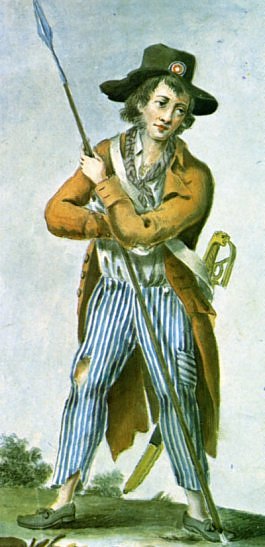
from https://www.france-pittoresque.com/spip.php?article8078 .
And this, utilising your article name Patrice:-
https://www.cairn.info/revue-annales-historiques-de-la-revolution-francaise-2018-3-page-11.htmThe minister did not specify exactly what is organic from the endowment. Who needs to be armed with pikes ? However, it gives two indications : “the service of the canon “, and the last two ranks of the battalions of the defence staff (while the first two are equipped with shotguns) must be armed with pikes ten-foot [7]
The Footnote source being-
Service Historique de la Défense (SHD), B 2 100, August 27, 1792, Servan-to-Biron.
and
A pike of the decree of the 1 st of August 1792, which could arm the military as civilians, is a weapon stamped “National Weapon” [31] Article 3 : “Each of these weapons will be marked on its iron and… that” shall not be less than eight feet in length, nor more than ten ” – which is about two and a half metres in a little over three meters. In fact, the pikes made in 1792 and 1793 will not exceed two meters, considerably less than what is prescribed by the law.
Case closed?
A remarkable analysis that someway dives into the Column vs Line debate as well. Tres curieuse??-d
02/07/2023 at 01:09 #187941 OotKustParticipant
OotKustParticipantTony additional to your answers there lies in paragraph 55+ … a clinical dissertation on why pike armed units failed.
Yet is doesn’t address the obvious concern that they were inadequately, or unsupported at all, by their own fusiliers… quote somewhat cleaned up for attrocious translation errors..
…The pikemen are certainly part of the arsenal of educational and repressive revolutionary.
After the month of June, 1793, the two battalions of the Somme are shipped to the Vendée. The first groups created en-mass August, 1793, formed in the departments of the West, were also transported to the Vendée. It is, therefore, on the domestic front the ‘pikemen’ of the Republic are involved in their first combat. The control registers identify the extent of the losses at the end of the clashes. This allows to indirectly determine what the fighting battalions participated.
Among these battles, those of the 18 and 19 September 1793 [61] Louis-Marie Turreau, Memoirs to serve the history of the… have been decisive for the fate of the pike. Indeed, on 18 September, the 7e battalion of the Somme, which was part of the division of General sans-culottes Santerre, is decimated at the battle of Coron. The troop of “Blues” is dispersed as it was moving forward in column of march. The people of the Vendée, faithful to their tactical rifles, have literally shot the pikemen who were not able to oppose them with the least resistance. The soldiers of Santerre have been defeated, and the panic has increased after the Vendéens have fired the guns of the republicans against the crowd of soldiers. The pikemen are left defenceless in the face of the fire of their opponents. The fifth company loses three quarters of its workforce, “killed by the Robbers,” as the announcement the control register of the troupe. The next day, 19 September, the division “Anger” under the general Duhoux is crushed by the Vendéens at the battle of Saint-Lambert-du-Lattay. Among Republicans, the battalion of the “fathers” of Angers would have been wiped out. It is not, therefore, a battalion, formed in 1792, but a unit hastily formed in the combat zone, composed of civilians and military that was available (the pikes).
The pike made a formal proof of its inefficiency in September 1793. Between 30 October and 6 November 1793-the reorganization of the army of the West at Angers. The mix of the troops of veterans of the former garrison of Mainz with the new levees is done within the new division of Mainz and of Nantes ” under the command of Kléber. It is probably from this time that it is necessary to date the second death of the pikes in the French army. In fact, after the battle of Saint-Lambert and of the amalgamation, pikes do not appear in account in the Vendée fighting, where the infantry of republican would have been defeated due to an inability to make fire.
In summary, the picnic has never been used in accordance with the provisions of the doctrine of 1792….
So it appears from such a brief synopsis that, unless one is ‘gaming’ the game in Vendée there is no way pikes will ever succeed as they need firepower support- apparently not present or tactically used.
-d
02/07/2023 at 03:03 #187944 Tony SParticipant
Tony SParticipantMy thanks gentlemen, for your prompt and knowledgeable answers. That was exactly my thinking. I did find a few pictorial artistic impressions of those pikes, but I’m leery of the accuracy of those, as I suspect the artists could be susceptible to shortening the pikes to fit into the “frame” better. But they seem to be confirmed by the official regulations.
Oddly enough, I was just reading the accounts of those battles today, from Ray Harper’s book on the subject. They are just begging for a refight on the tabletop! As an owner of a Successor army, and of several Renaissance armies, and a Russian GNW army, it’s in my DNA to field forces with pikes…even if they aren’t quite as successful!
On a more prosiac note, the only semi-suitable figures might the Irish pikemen from 1789 from Irregular, albeit with the pikes cut down. OB made the observation in another thread, and I think he’s right, that they aren’t quite French peasant looking, but I don’t think I’m exactly spoiled for choice in 15mm. Although the old Chariot range from Magister Militum has a nice pack of Paris Mob that seems to have something useful.
Same with the Rebels’ cavalry; other than the Irish horse from the same Irregular range, I don’t think there’s much else.
03/07/2023 at 23:07 #188043 OotKustParticipant
OotKustParticipantAs I posted in my update
Merely a ‘service announcement’ – http://frederic.berjaud.free.fr/articles_en_ligne.htm July First- Frédéric Berjaud has again updated a swathe of regiments…
there’s a purpose behind what some think as madness. That is, unless you read through them, you may be unaware of valuable (to some anyway) snippets of information that help define and/or corroborate other ‘general truths…’.
Despite a concern on reliance using Martinet prints in the articles themselves, there are these documented gems… in the footnotes/ captions one finds for the 2eme Legere:
Figure 3 : Les tenues du Bataillon d’Elite, 1805-1806. Le 16 Février 1804, Napoléon ordonne à Berthier de fournir des sabres, des épaulettes vertes ou rouges, des capotes et des bonnets qui manquent aux Compagnies des Grenadiers de la Réserve d’Arras.
Figure 3bis : Voltigeur du 2ème Léger, vers 1805. Formées en mai 1804, les Compagnies de Voltigeurs prennent le shako sans jugulaires. La plaque est encore de laiton. Les épaulettes et le collet sont jonquille. Les parements sont encore en pointe et écarlate comme en 1802-1803. Le sabre briquet des Compagnies d’élite a une dragonne jaune.
So several points to confirm. From Napoleon himself, unless we malcontents of uniformolgy suspect him of gratuitous lies..!
- Capotes/ greatcoats- general issuing of to the corps
- Bonnets/ bearskins- fill-in provision to the corps Grenadier/ Carabinier companies.
- Voltigeurs- yes we know decreed in Feb 1804, not necessarily created then; however we also know that ‘eclaireurs’ existing in many legere regiments for several years prior. So it is entirely probable that they did get annointed rather quicker than the line would in 1805.
- Secondly the adoption of ‘chamois’ and yellow distinctives, modifying existing scarlet attributes would be a job for tailors but not onerous for single companies I imagine.
- Epaulettes and ‘dragonnes’ were bought in from external clothing milliners, so much easier to add to uniforms. Incidentally the citation confirms the sabre-briquet was issued to ‘elites’ if not chasseurs in some units.
>>there’s a purpose behind what some think as madness. <<
Yes my own being I am completing in 25mm Junot/ Oudinots ‘Grenadiers de la Réserve’- alongside my IV Corps de l’armée– the ten battalions of N. ‘alternative Guard**’ that did enjoin combat actively in the 1805 campaign, and in future others, and the individual dress of the combined regiments is fascinating detail to me.
Is it all available in one place and complete in every detail? Certainly not!cheers d
**Some people think Napoleons precious corps was his only one- however it is well documented that he both sponsored, organised and created many ‘informal’ ceremonial but well dressed and accoutred public relations/ security guards throughout his life.
La Garde Imperialé is merely his most obvious creation, built from a very basic need.09/07/2023 at 03:43 #188229 OotKustParticipant
OotKustParticipantPatrice wrote: there was a long article of Michel Petard in Tradition Magazine n° 69, October 1992, “La pique de 1792“. Dang! I have few Traditions- Uniformes mostly in my collection- I should peruse an index for them!
Tony,
I have AN article in Gazette des uniforms Volume N#2; aka same #25 June 1975 entitled ‘La Pique de l’An IV de la Liberté’ .
It is fundamentally ‘the commencement of the weapon’, ordnannce issued by the Assemble Nationale in the Kings name… and manufacture in detail. Nothing about its’ use.
Would you like a ‘photo’ copy/ scan of it. Quite a few detailed pics including one ‘scaled’ with a rennaisance (mareschal de Saxe) pike.
cheers d14/08/2023 at 22:59 #189569 OotKustParticipant
OotKustParticipantNot uniform, but ‘best practice?’ regulations/ advisory/ do as you want kind of thing-
PLD being a ‘horsey-guy’ has cited a couple of times some regs that:
“officers are not to have mounts that are whites or greys, as these will highlight their roles and make them targets;… reserved for trompettes so they can be located in line of battle…”
And on horse colours in general- many regiments managed to mount their first squadrons on blacks, but much of regiments balance would not be.
He cites that if possible, the preferred French heavy ‘Norman’ horse wasn’t dark as black, yet those preferred were darker browns etc., even the exclusive Grenadiers á Cheval didn’t get a full complement of them!
Of course, even N. didn’t follow the rules he imposed…
-d
21/08/2023 at 19:44 #189839 OotKustParticipant
OotKustParticipantFound this in a sidebar search -> went from current historian to facts database, thence led to contemporary (ie Napoleonic period, or should that be Bonapartiste to suit the woke among uuss? )…
A grossly mislabelled painting, the undated, presumed work of well known JOHANN BAPTIST SEELE, proving that even auctioneers don’t know what they have some times!
It is labelled as ‘Landwehr’ yet couldn’t be further from the truth. It is a magnificent painting and photographic copy that you don’t find too often. Also cited as “around 1796/98 “ which has to be the biggest WTF I’ve seen in a while
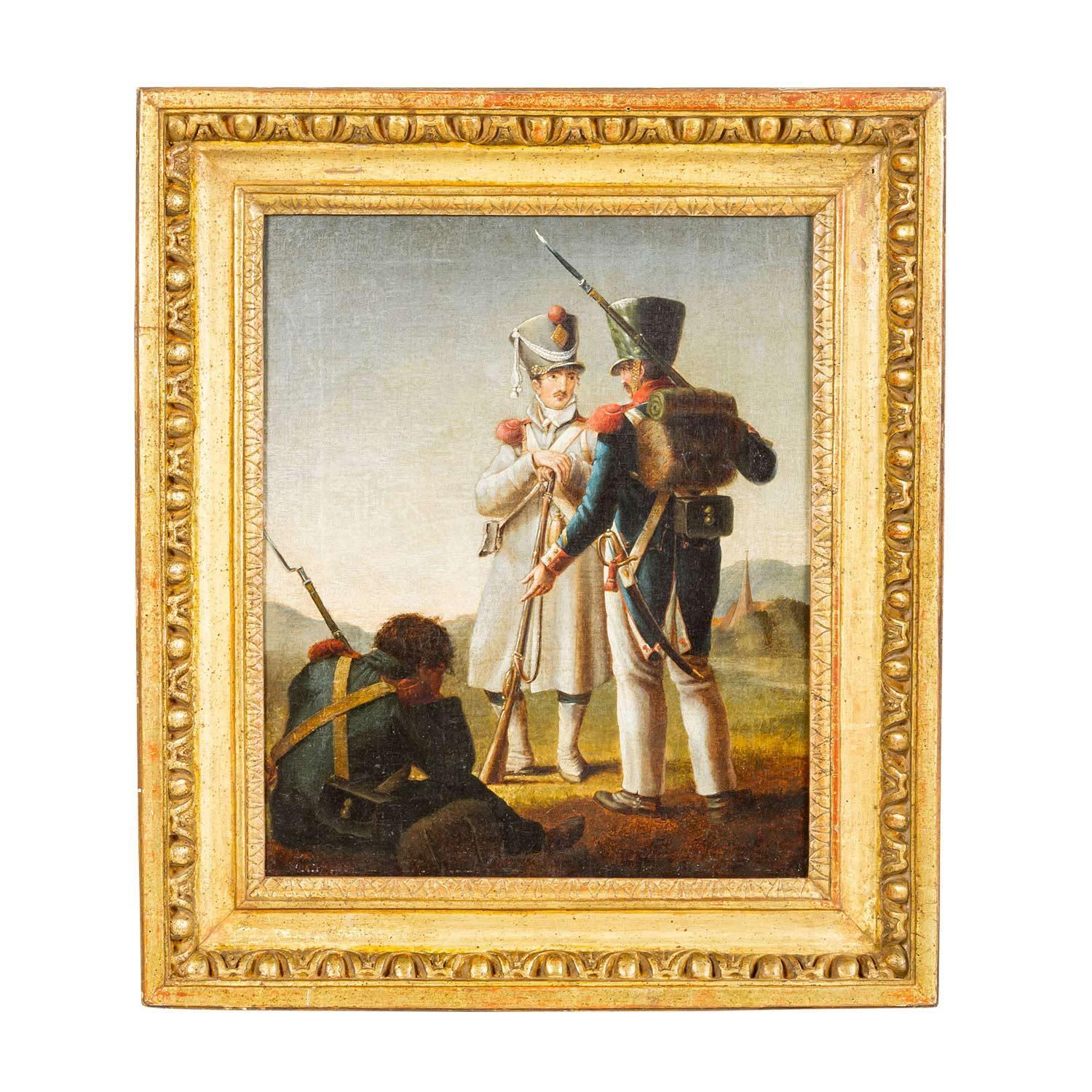 So let’s state the obvious to any fan. Three French grenadiers, or carabiniers, regiment(s) unknown, shown in a variety of dress.
So let’s state the obvious to any fan. Three French grenadiers, or carabiniers, regiment(s) unknown, shown in a variety of dress.- Back to us is a sergeant, denoted by his slightly lower than normal but otherwise correct gold lace above the cuff. Everything about his uniform is correct down to the size of buttons etc. Whether his lack of other rank distinctions is correct is a situation of later periods adopting more attributes perhaps.
Even his habit tail length is accurate- terminating just above the knees. He wears a shako cover, not often given in European scenes like this.
White linen overalls (clean) cover his gaiters and show above his shoes.There is no sign of the ‘combined’ sabre-briquet and bayonet belt housing, so this too is consistent for the early period. The fixed bayonet confirms he is on duty.Overall a truly typical Napoleonic French soldier.
The only possible anomaly is the smallish capote rolled on his pack, or it may be his personal sleepng bag perhaps. Having just worked with some ‘foreign’ figures, Germanic nations did exhibit smaller coats up there. - Our next grenadier in a longer manteau than the French issued capote. So perhaps, in spite of the French ‘white/ grey’ colour (pique de bleu), it is an ‘acquired’ piece of uniform.
His detailled shako is a delight. Probably pre or at least 1806 design, there is no sign of the reinforcing chevrons that became common issue; the small brass lozenge plate, no attempt to detail or show a regiment here; and the pure white cordons and plaquettes in usual double braid, extending front and back (not all regiments did this).The red (scarlet) pompom slightly low and perhaps concealing the cockade- or that may have been retained on the left hand side, we cannot say.
Both men wear brass trimmed peaks and chinscales.
His cravate/ mouchiour being white indicates a non combat role.
He appears to be wearing blue breeches- and the short white gaiters may indicate a legere regiment, so perhaps he’s a carabinier?
The musket is a little short, so perhaps he also is an NCO and using the infamous rifled carbine with which they were issued? - The last figure, seated and obviously suffering some ill effects, also appears in blue overalls perhaps confirming a carabinier also?
He has removed his standard issue knapsack and for all intents also is typical, if hatless. The yellow/ buff belts I am assuming is merely the artist giving the ‘shade’ to the figure in general.
There is no detail in the mans habit as shown, but all the cartouches are similar in form and with flaming grenade badge in brass, showing their status as we expect.
While the given date article is clearly in error, I would put this illustration at 1806 or 1807. The troop uniform and equipment are typical and show some but not all of what became more structured in 1808/09 reorganisations in France itself.
Given the artist is German, and painting in Stuttgart, just East of Strasbourg and the Rhine borderlands, which was as we know both a staging area and transit stopover for much of the period.
I will add the full size photograph on Flickr so you too can blow it up to see the details, as published below on web aggregator auction site:
https://www.invaluable.com/auction-lot/seele-johann-baptist-messkirch-1774-1814-karlsruh-1617-c-43d4792bcdregards
davew26/08/2023 at 00:49 #190003 OotKustParticipant
OotKustParticipantThe Carabiniers á Cheval for 1800-1807
Sorry not new content, but ‘copying’ from other to this I think more appropriate labelled thread:-
Heroy wrote:
Looking only at contemporary images, and awaiting Mr. Dawson,..Invoking some other research, I reopened my chest of wares and in the Gazette des Uniformes I have found some more, exotic and pre-1807 contemporary illustrations. for the Carabiniers. So I will photograph and post these tomorrow in deference to my conceptions (which this article clearly influenced a long way back but I’d forgotten [again]…) Perhaps my delaying until we see the ‘Dawson Manuscripts’ published won’t be necessary- I should just get on with the job!
Of course I also have to create the General and his entourage (along with HIS general, the great Nansouty et al). -dave
– – – – –
Part One
The Carabiniers á Cheval– an elite ‘brigade’ of paired regiments continuously maintained from the Ancien Regime through the entirety of the Revolution, Republican and Empire of France.
They took the right of the line- as both age and status granted their rights over mere cavalry.
Most famously highlighted for their uniforms first, and their actions second. Michel Petard in 1977 traced the use of ‘carabines’ amongst the 16th Century development of light cavalry- a pair of them to every compagnie. This expanded to a full compagnie, that is half an escadron, then…
The famous bearskins, oursons, date from 1791. Always with white cords and tassels, only the specific regulations of 1801 cite scarlet wool- yet these were apparently never worn (if even produced). The similarity of Grenadiers á Cheval and that of the a pied form, were being compared and aligned. Not so in either case actually. Such are the vagaries of men, power and decision making, seldom aligned it seems.
Thus my consideration, when forming such regiments for gaming (only one at first) was to use the existing figures most closely available, since no accurate 25mm figres were made. And the horses. Ahh yes, yet more variation in horsey culture and depiction. The ‘1808’ designation of their uniform, didn’t really change much, but the horse saddlery was highlighted, with a somewhat anachronistic round portmanteau. Wait! What? Those were used by light cavalry, not the heavies, weren’t they? Well, yes and no. Since 1808 is not early Empire, but a short slice of peace time, my consideration was for what was used in 1805- itself the end of a period of restructuring and reformation more controlled, yet with rather loose edges, for almost the entire French armed forces.
To cut to the chase, or is that a pursuit…?, we have a variety of period material offered by M.Petard and his own conclusions, in his series ‘The Man of __ ‘insert year here‘- in this case- 1807. He shows what came before, according to artists and documentation, and what followed for these men of war.
Petards illustration shows the same sheepskin we know about, but with a square portmanteau topped with the white/ pale blue (drap blanc pique de bleu) but grey at a distance, capote or manteau. The article header includes a Martinet illustration- not I hasten to point out one of the 1821+ series that were intially printed but later mere engravings that suffer the ‘copyist’ problem of reproductions brought down to us.
The same attributes, but this is an original document, taken as a sighted example by Martinet of uniforms from 1800-06, as the caption states. Neither of these helps with saddlery as the sheepskin protective cover is shown. However another original, from the Library of the Musée de l’Armée does show this.
The matched pair of holster covers are laced and the broad lace of the saddle blanket, all white remain the same. These holsters are those same as used by the Consular and Imperial Guard regiment, the Grenadiers á Cheval.
So we have a distinct variation from the ‘norm’ of modelling these. The use of the sheepskin ‘blanket’ was for two reasons- protection from inclement weather of the invaluable pistols and powder kept in the holsters; but also as a riding aid taking the aggravation out of saddle time AND clothing wear- breeches suffered whereas the lanolin in the [natural] wool of the whole or part sheepskins provided a frictionless padding. So there was science involved in the reasons they were utilised.
Other variations of uniform and equipment exist, such as this painting of a lieutenant ‘charging’ at Wagram 1809. Not only is the red plume missing (we are accustomed to paintings depicting soldiers, particularly elites, in ‘full dress’/ Grande Tenue for battles as parades. Some pragmatism had become evident in la Grande Armée since the arduous campaigns of 1806/07 were completed.
This also illustrates a debated issue- did they have chinscales or not? It seems to have been an elevated issue even then. The ‘reversed’ position of the cordons (right instead of left) may be a result of error, or preference by the ‘new’ officer; along with second or campaign dress blue overalls protecting or replacing the expensive breeches. The last point of a slightly larger stylised horse blanket but with an expensive ‘leather’ seat in lieu of sheepskin; and a single covered holster, also a feature of second dress and equipment.
Finally, the ‘traditionally’ depicted carabinier of 1808 ‘renewal’ most religiously modelled as the only form; here another and the later versions from Martinets dossier-
yet still showing the double holster covers. So, is this the true version? Well, is there ever such a thing. Yes, we can choose…
The article has a couple of other illustrations but I will hold those for later. Trust this helps anyone interested in making ‘unique’ units for the early Empire campaigns,
regards- davew
– –03/09/2023 at 03:16 #190245 OotKustParticipant
OotKustParticipantAnother aside-
perhaps I regret entitling this thread ‘Uniforms’ as a number of issues/ myths need the fresh sunlight shone upon them.
We all know about the French Revolutionary Governments’ Calendar- its purpose and reliance- and we also know about its termination, effective on January 1 1806 when the Gregorian calendar was reestablished as the governing date system in France.
But did you know- that in fact the Gregorian calendar never really went away. As shown official Government documents we co-dated in both forms. Here we see just the header of an arrest warrant for a soldier of the 4eme Legere who committed thefts and assualt on a superior officer (First Division is of course, Paris City).
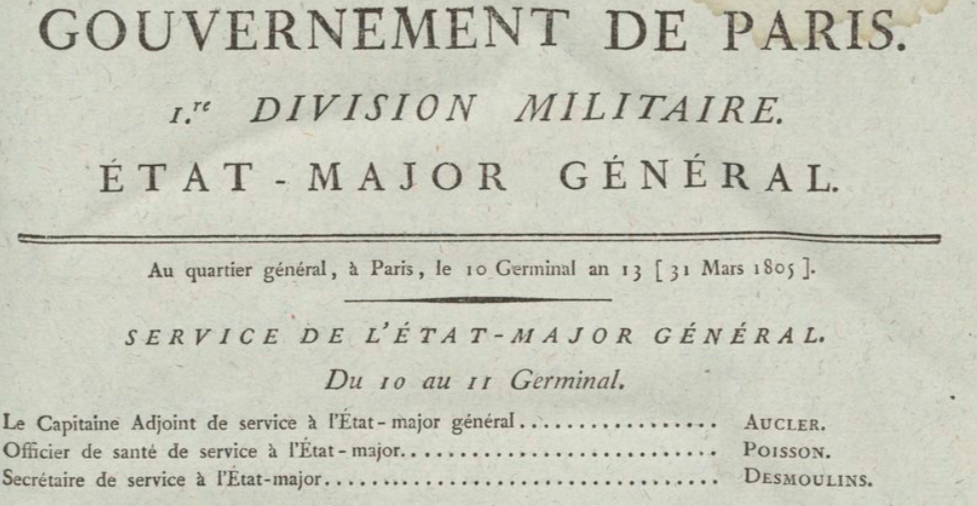
So not everything is cut and dried so to speak, just because a datum is attached.
Life existed beforehand, and thence continued the same the next day after; perhaps, at a future time, changes were made; but they were made in effect following prior rules and guidelines, or traditions, and little was as specific and direct as both ‘historians’, artists and gaming lore makes us believe.
“Quant aux estampes représentantdes chasseurs de la Garde, elles ont abondé, surtout à partir de la fin de l’Empire et des progrès de la lithographie; les plus anciennes de celles signées des Vernet, de Charlet, de Bellangé, de Raffet, sont très précieuses au point de vue de la conservation du type des soldats, que ces grands artistes avaient eus sous les yeux, mais elles ne fournissent point en général d’indications de détail assez précises pour les peintres actuels de là les recherches minutieuses de Meissonier, dont les reconstitutions sont des chefs-d’œuvre.”
So states an author in ‘Soldats Autrefois’ -Tenues Oubliées in ‘La Sabretache (Paris ; 1893-1970).
Carnet de la Sabretache : revue militaire rétropective/ publiée mensuellement par la Société “La Sabretache” 1895.Thus we read the observation that period artwork, was probably copied by the greatest military artists of the 19th Century, in detail and form and supported by actual preserved articles, to complete their ‘pictures’. Detaille as we know was an ardent ‘collector’ and much/ all of his property contributed to the magnificence of the Musée d’ Armée.
Au Contraire!
On the contrary, one of the gravest travesties of writing and still occupying space on the net, unaltered with many factual errors and based upon completely second-hand sourced material, gaffs abound, is:-
https://www.napoleon-series.org/military-info/organization/c_corses.html .But enough on that, some things won’t change in a hurry either.
regards d
13/09/2023 at 04:08 #190542 Mark OParticipant
Mark OParticipantGreat post and discussion thanks!
My Napoleonics Blog: https://chasseuracheval.blogspot.com/
My Other Hordes Blog: https://hordesofthings.blogspot.com/13/09/2023 at 21:56 #190573 OotKustParticipant
OotKustParticipantGreat post and discussion
Thank you Mark for comment- really appreciate from someone of your status in the community.[Yes I have looked over your site and info frequently, just never comment…].
I’m replying simply because I may be gone for some time, err no- just in an hour getting laser eye treatment at our favourite public hospital, so no doubt I shall be quiet rest of the day, I’m guessing…
regards davew20/09/2023 at 00:25 #190780 OotKustParticipant
OotKustParticipantAh yes, the shako!
So many depictions- mostly we are familiar with the 1808 ‘style’, full dress version (elites with plumes and on occasion some fusiliers shown (fantasy??), plain plates or eagles, large cocardes front and top, brass chinscales and extensive plaited cords with racquettes dropping, mostly to the right.
With or without leather reinforcing chevrons etc. Numerous variations existed and many an illustration shows these too.
{Edit Nov23}
Many features [of chapeaux, shako and helmets_] are legacy attributes of their respective regiments. Familiar history and artifacts were not given up quickly under men who rose through the ranks of the Revolution, and now commanded N.s regiments!However, re-reading the superb article* by Frédéric Berjaud on his site http://frederic.berjaud.free.fr/1eleger.htm on the !er Legere he includes this snippet quotation from a Rousselot plate text:-
Some precision on the shako: that applied in 1804 – “had to comply with the one that describes the order of the 4 Brumaire YEAR 10 (October 26th, 1801).
Felt, with leather top turned down on body, includes a cockade on the left [side], retained by an orange braid fixed by two brass buttons and concealing the fob [whalebone shaft] of the plume;
a brass plate “cut out in the form of horn”, representation of which, and an attachable mobile visor with hooks.
This shako was ornamented with green cotton cord terminated by racquettetes and glandes, and a green tall plume of 21 inches (567 mm)” (Rousselot, Plate 5).He does poke I think some errors suggested in Osprey/Haythornthwaites ‘Napoleons Light Infantry’.
An outstanding relic is shown, sadly neither detail nor in colour, and IMO a somewhat erratic addition of a non-original cord, both in form, colour perhaps (too light, maybe it’s yellow/ chamois?) and placement.
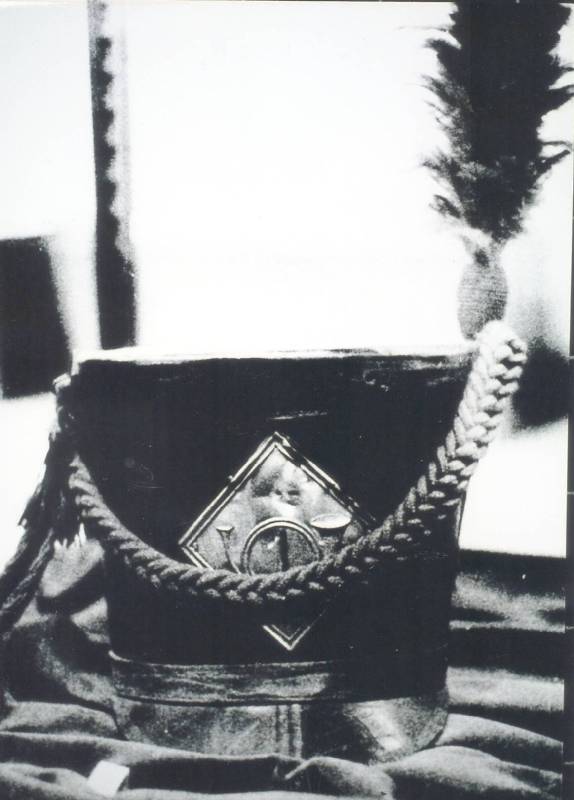
#11e face: A shako after 1804; perhaps of 1806, being attributed to the 1st Light – in Collection Titeca, Brussels (photo private collection).
It does not seem that it is can be model 1801/04 with a removable visor, nor the model 1806 with fixed peak; perhaps a modified model 1806?The regulation plate (hunting horn with 1 in the centre, the cord and the plume placed on the left side, as in 1804 will be anyway noted; this last is fixed in an olive or ‘bulb’ pompom.
Clearly there are glands/ tassels [both sides] that are a darker colour, most likely green, so the ‘replacement’ of a heavier braided cord seems a convenience rather than authentic.
Nevertheless a good example that few model manufacturers have created, the ‘early’ Empire being less popular.
Lucky for me Miniature Figurines created one, a single entity, that I have used and extensively customised as well; many of my elites have been similarly ‘adjusted’ to the earlier version.
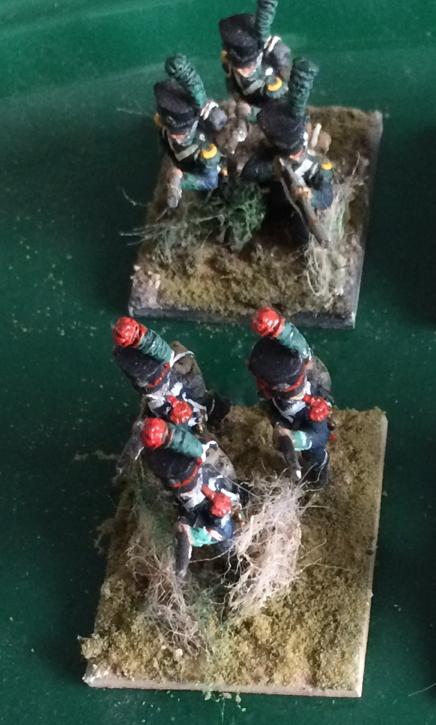
cheers -d
20/09/2023 at 23:12 #190800 OotKustParticipant
OotKustParticipantJust adding this as I bought Dempsey’s ‘Napoleons Soldiers’- the epic masterpiece on the a.k.a ‘Otto Manuscript’- not the painters name but the 20thC person who ‘sold’ the originals prior to WWII… subsequently sold then donated to NYPL.
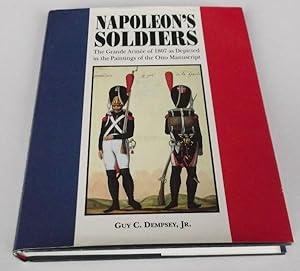
But I digress… it has multiple examples of ‘white’ habits as described. ((Edit))
This site in addition___
http://warfare.cf/19C/FrenchWhiteUniforms1806-7.htm?i=1Whilst doubt is now thrown on the exact/ potential original date of the paintings uniforms- gouache as Dempsey describes, they cannot be taken as less than fine examples of the variation, or similarity if you go glass half full way, of such military creatures between 1804 and 1809 inclusive.
That uniforms of any nation weren’t and couldn’t be replaced wholly and army wide, let alone all over the continent, is patently misrepresented by ommission almost always.
We are now far more pragmatic about the implementation of such variables, where were units?; how were they supplied?; need for replacements etc. all applicable.
[Edit +spelling] Not having seen the book when first released, in 1994 – (I thought I was buying a reprint of 2005), I’ve scraped various images from the net over time- nowadays a less than satisfying effort than in past. So for £6 who would ignore such a bargain- Caliver Books to the rescue!
And in excellent condition, well worth having ‘even if’ most of the content is later than my envisioned use dates- nevertheless GuyDs descriptions are themselves useful for highlighting differences and similarities over contentious points.
Relevant to an acid, or is that caustic, critical thinker…regards -d
06/10/2023 at 06:21 #191252 OotKustParticipant
OotKustParticipantMerely a cross reference to my separate article (being progressively updated with new or revised information) https://www.thewargameswebsite.com/forums/topic/minifigs-horses-adapting-and-utilising/#post-191251
given the similarity of equipment supply to uniforms. After all, we can’t not have cavalry in our forces, can we?
regards -d21/11/2023 at 04:51 #192735 OotKustParticipant
OotKustParticipantI note, sourced from Berjauds fine and scholarly articles (this the 4eme de Ligne) again submitting a change to uniforms, harking back to the ‘Revolutionary’ period again.
One correspondent commenting on the disaster that befell the 1er/ 4eme de ligne at Austerlitz (losing their Eagle after 3 Porte-Aigles NCOs were killed by the Cavalier-Garde cavalry) that a slightly cynical comment from Major Bigarré concerning reactions within the French Army:
The 4th line was one of those corps which had waged the first war of Italy under the Emperor. After the ‘nice affair’ of Arcole, where this regiment distinguished itself, General Bonaparte allowed them to wear (coloured) gansés on their chapeaux, similar to those of his ‘Guides’; this kind of particular decoration hurt the self-esteem of other regiments of the army, so that many colonels and upper officers did not see the ‘unhappy event’ of the 4th regiment at Austerlitz with feeling of displeasure”. (Major Bigarré)
I’ve never before seen such a reference to the ‘ganse’- the double-row of lace ribbon stretching from the cockade to the uniform button attached at the base and back again… as an ‘award’ or honour to be differentiated by regiment or by decree.
{Edit Nov26}
A further note from Berjaud on these illustrations he’s used, cites some correction, seems the Bigarré statement misinterpreted the hat parts – “Le détail de son habit laisse apparaître sur les retroussis des étoiles bleues; le chapeau est garni de passants aurore, caractéristique qui durera jusqu’en 1807. ”So it is the ‘cords’ of the chapeau, those that go around the head and pass like strainers back and forth, retaining the flaps upright, ending in the corner ‘tassles’ of which he speaks.
Interestingly he also points out that Rigo depicted three different variant uniforms illustrations of the same affair,… [ Minor Edit for clarification- dec28 ]Illustrated here by Rigo, correct or not:

I note Bucquoy shows them coloured much of the time, others plain white; Brunon brothers plates equally show aurore or orange perhaps without comment.
I have, habitually, added them to
allmany of my bicorne hatted infantry (mostly customised figures for the ‘early’ Empire) regardless and this revelation, buried among the mass of data is a surprise.My example of the 3eme de Ligne (Third Division- Le Grande):
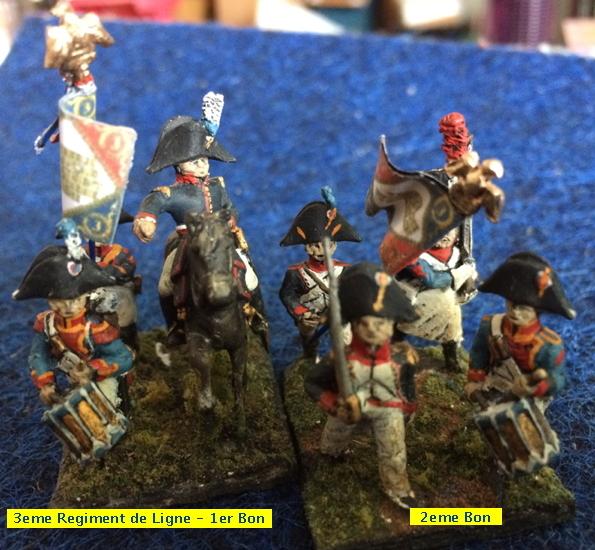
I’m not actually modelling any of Soults Second Division (Vandamme) so the 4eme for me, doesn’t exist- but many others do.
Does anyone know more specifics about the 4eme that justifies such a comment?
-regards d30/11/2023 at 02:03 #192958 OotKustParticipant
OotKustParticipantSome time ago I tripped across a site,
need to find it again–a gaming site but one with much in way of technical and historical publications- all now available as pdfs rather than on-line reading. Most written in the last 20 odd years, but quite a bit earlier as ‘gaming’ was the focus.
Heres the applicable page with many, many attributed articles :-
http://www.planete-napoleon.com/rubrique.php?id=3
Found under menu ‘Histoire Militaire/ Articles…’Some parts are headers with a mass of compilation pdfs in trivia and gaming.
This one best perhaps facts ex-archives again, on the Cavalry of La Garde- 1814. (In French as you’d expect…) by a gamer/ historian.
His introduction goes:-
In principle the subject may seem easy, as it is the most famous of all the cavalry formations whose hooves trampled Europe from Madrid to Moscow. But this is not the case, and far from it. The brothers Brunon, Jean and Raoul for the intimate, addressed the issue for one of their works, and issued as specialists the following sentence:
“The difficulty increases because the detachments arrived to the Army at irregular intervals, because the organisation of the cavalry of the Guard was constantly changing according to the needs of the day and sometimes of the hour…”
In short, all the reasons leading to what I have already summarized in an earlier search by the phrase “a real basket of sabres.”Having seen and possessed both their collection and writing, this is worthy of attention!
-dave02/12/2023 at 04:22 #192997 OotKustParticipant
OotKustParticipantJust adding this as I bought Dempsey’s ‘Napoleons Soldiers’- the epic masterpiece on the a.k.a ‘Otto Manuscript’-
But I digress…The Final Say:
Finished scanning Dempseys Napoleons Soldiers (Otto Manuscript illustrations). Overall the text has many confirmations of period dress, regardless of the typical time/ date attached to these; definitely shows the variations of uniform and that pre-history should be taken into account.
He conveys the variation, both of illustrations themselves but also his genuine knowledge, or research, found among other references and existing articles of clothing or equipment.
It is only in the latter stages that he openly acknowledges the variations were conceivably created because of changing criteria (ie regulations and manufacture); other sources of procurement; and lastly that issue of ‘reinforcements’ dressed in a different manner or from a different source to the existing regiments. Thus we can justify the differences between depictions.
So although this exists, there is no 100% right or wrong. By date, by type or due to deterioration, things change.
And I will be eager to compare once the PLD tomes come out and see where, these values match or mismatch. Only then can we say we have examined the issues properly…cheers -d
25/12/2023 at 04:17 #193660 OotKustParticipant
OotKustParticipantMaybe I should have called it MythBusters, but that was taken…
Researching near unknown units you find some things, and then wonder.
The ‘Amalgams’ of the Revolution always bugged me- they were complex deconstructions and reconstructions seemingly without rhyme or reason… but then I found the man, the late Bernard Coppens had made it all simple, traceable and I have to say better than SEHRI have done with theirs.Never mind- here the 43eme de ligne, began…
La 43e demi-brigade de deuxième formation a été formée en 1796 (arrêté du 18 nivôse an IV) de :
– 34e demi-brigade de première formation ;
– 3e bataillon de la 149e demi-brigade de première formation.D’après l’état d’emplacement publié dans le Journal militaire du 10 vendémiaire an VII, la 43e demi-brigade de ligne était, au 1er vendémiaire an VII (22 septembre 1798), à l’armée d’Angleterre.
And therein reveals another MythBusters Moment- always getting put on record that so and so created the l’armée d’Angleterre, aka Armée de l’ Ocean Cotes.
Well no, as you can plainly read, it existed years before hisself the l’Empereur created his ‘Camp du Boulogne’ of great fame. HE wasn’t even in France at this time, and I have no idea whether he ever went there, but it was there at least a year before he returned from the East.
True it wasn’t the same form- he did increase and strengthen fortifications, created living quarters and barracks out of the modest originals; had the men build their own barracks where a caserne or billeting just wasn’t going to work in the agricultural regions of Northern France, and others.
He gave skills to his conscripts, created industry and [ mercantile ] wealth amongst the merchants up and down the coast.
When in August 1805 the army left, others moved in. How well that deceived the British Navy and their masters I know not, but thats another subject altogether… not much for the cogniscenti I know, but hey it amused me to find another tripwire in the tangled web of history…
cheers -d26/01/2024 at 22:47 #194658 OotKustParticipant
OotKustParticipantJust an out-of-date query for me… recently posted by an author of such things, anyone identify the artist (as it wasn’t referenced in original post) and unscrabble the faint caption given?
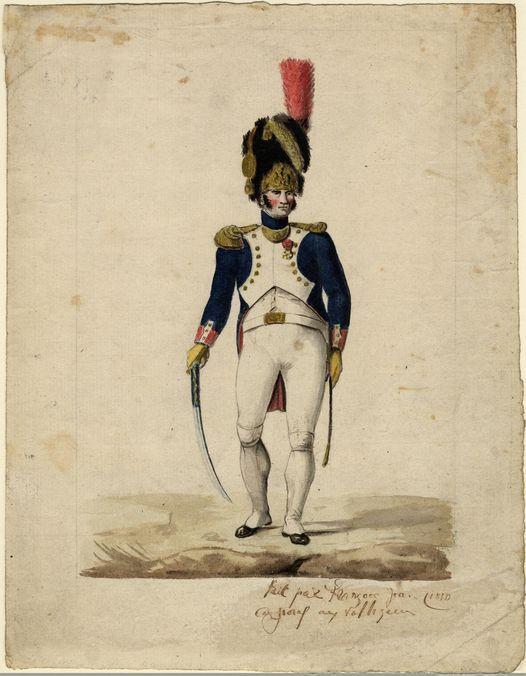
Clearly an ‘adjutant’ given the reversed epaulettes, and 1810 from the caption I can read.
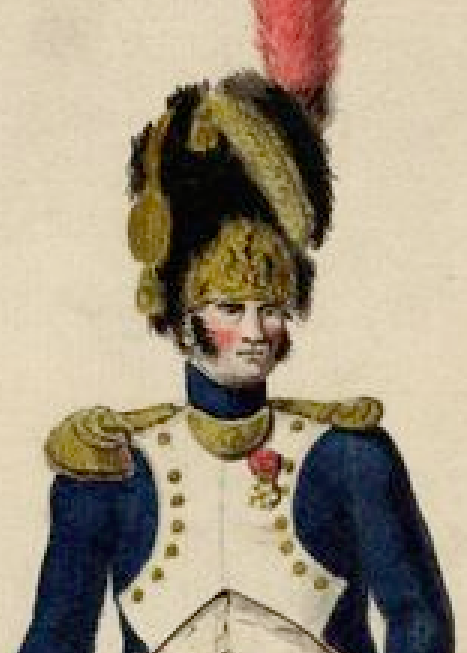
On the close up we can see a few anomalies to known uniform- clearly there is a second colour at the base of the plume- black? Perhaps green? Though that would be strange given he is an officer from the Grenadiers.The lower row of gold under the epaulette fringe proper?
And the doubled threaded cordons, joined by a single thinner one, seen on some line cordons where twisted cords are not prevalent (particularly early years)?And finally the caption-

A name or other designation?
The last line apparently ‘Adjutant au Voltigeurs’ – can only mean a seconded officer to the newly designated/ forming Garde Imperiale Voltigeurs.Any ideas? Thanks
~d
07/02/2024 at 20:26 #195082 OotKustParticipant
OotKustParticipantWell another tumbleweed in history…
Our friend/ frenemy PLD recently dropped some more hints- this time about regimental children, and coincidentally drummers, tambour, posting this undated and description free snippet:
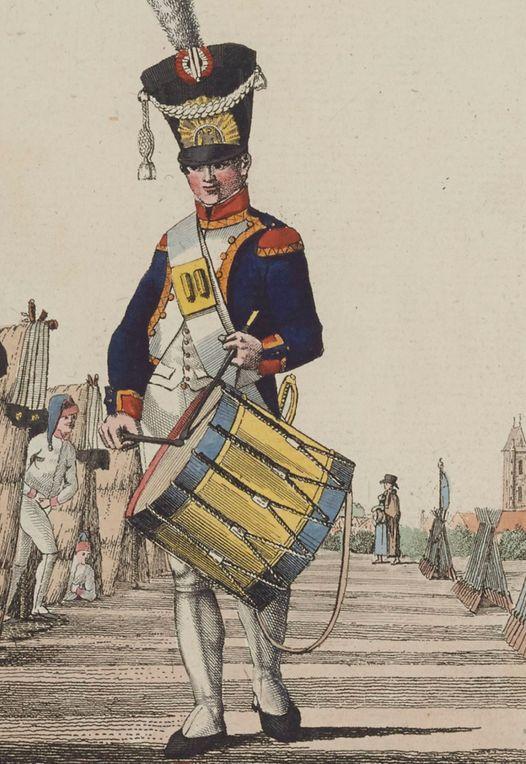
Shame about the plume [being cut off] !
Interesting, what appears ‘mid Empire’ to me- the gold lace applied in exactly the same form as per the 1786? regulations. Being gold laced he is perhaps atypical as well, a bandsman rather than ‘in the line’ drummer.
Another facet noted by PLD as a consequence, is that not all ‘de ligne’ drums were ‘brass’ as so often depicted. In fact he cites a few regiments where ‘all wooden’ drums are recorded. That probably explains the ‘painted’ versions seen, particularly in the Revolution. Guess we have to wait for some extremely bloated tomes later this year.
NB- as of writing today the awaited ‘Heavy Cavalry’ has still not been published, per previous press of end-of-January announcements.
[ *Edit-Feb24 ]- Release date now revised to April’24.regards ~davew
23/02/2024 at 20:18 #195514 OotKustParticipant
OotKustParticipantOh dear, I read yet again some scurilous assertions on the ‘normality’ of French uniforms ; ‘We are indeed in a time of turmoil… ‘
Paul Lindsay Dawson
Again, I hate to point it out, the 1806 decree for schakos was NOT acted upon till winter 1807. 80% of the army was in chapeau in winter 1807 and were not authorised to issue schakos till February 1808 and the process was not complete till 1809/10. Again, the 1806 schako is ‘phantom’ as an item. Some unit of course did not wear chapeau, like the 29e de Ligne who wore captured Austrian helmets, I digress. I can bore on this subject, and can comfortably say that most books on the dress of the French Army are wrong.Going to be a long year…
Meanwhile, my ‘allies’ will get some work done!
– d 🤣26/02/2024 at 16:46 #195565 OotKustParticipant
OotKustParticipantMore data points to raise following my primary list 1-11 from #187895 above…
-12- Plumes- the feather variety of generic troops rather than specialty officers and command models.
In colouration- the differences are arranged, where multiple colours co-exist, in fairly set proportions- 1/2, 1/4s, 1/3rds and even 1/5ths. Where and why these vary depends upon circumstances.However it is a ‘feature’ that once a parameter is set, it appears to be uniformaly (sic) applied throughout a regiment.
Thus we can note:- Garde Imperiale Chasseurs á Cheval- base 2/3rds green, top scarlet
10/03/2024 at 07:09 #195967 OotKustParticipant
OotKustParticipantIf anyone was reading, apologies for the cut-off above- there was a mini-crisis meaning my attention was diverted for several hours, and the unprepared dissertation truncated accordingly.
Now, on an organisational matter rather than uniform.
We read frequently and incorrectly this matter of, late Consular period of supposed peace- how many battalions existed in the French infantry regiments?
Not-
When Napoleon issued “one eagle per infantry battalion” in 1804, there were only two battalions to a regiment.
As I cited sometime later, an incredibly incorrect and abstractly perverse statement. Why?
Well, it doesn’t take a genius to find factual statements of how many were issued and to whom. ‘3’ being the magical number for, what was called a ‘Demi-brigade’ until 1803, thence Regiment, because a half-brigade was, mostly and literally three battalions.
I seem to have misplaced my source response, but there was in 1803 and following a majority of fully equipped 3-battalion regiments; a small number contained 4, and an even smaller number had only two.
These latter were left overs to some extent- dwindling units with overseas detachments where they became amalgamated (eg San Domingue), and those too were often amalgamated in France.
Such a process resulted in several of the ‘missing’ regimental numbers. The demise of the 11e Legere is but one, resurrected some years later from the single elite battalions of the French Army.
______regards d
05/04/2024 at 23:08 #196845 OotKustParticipant
OotKustParticipantMeanwhile… suffering with a bad case of the ‘flu’ so if incoherent mistakes occur and remain, I apologise.
In the little reading I have been able to do, and beyond my period of interest, I noted in a recent Jonas De Neef Chronicle this snippet about an actual uniform- sadly he hasn’t included the actual letterhead that depicts it!
https://napoleonchronicles.wordpress.com/2024/03/22/three-letters-from-j-j-delvau-soldier-of-the-imperial-guard-1812/So now I will give you some details of my uniform: I am dressed like the portrait you have before you (1) for the grand uniforme; and for the petit uniforme, we are dressed in a grey great coat of fine cloth and the buttons bear eagles. We own three pairs of shoes and a pair of gaiters. We also have grey canvas trousers, and we are equipped with all the paraphernalia we need.
So there you go, confirmation of a ‘dress’ [grande] uniform and ‘other’- the petite used until ordered otherwise.
I imagine these latter copies would however sufficiently indicate:
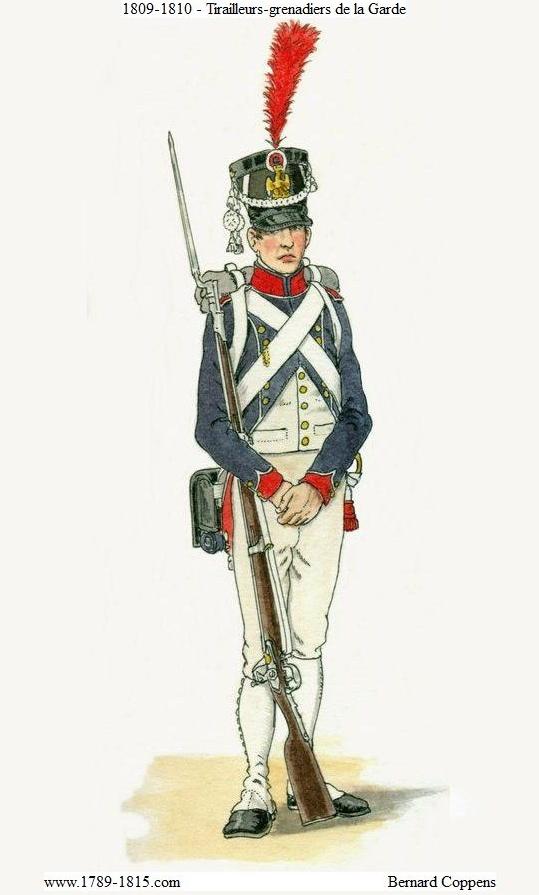
And if you want to see one of the most-ill defined, or badly populated web page for a professional- 15 years after creation! — then this is it- appears to be a NCOs habit with unusual silver lace on epaulette edging*, plus silver grenades that may or may not be standard.
https://fraysse.net/listings/shako-de-troupe-de-tirailleurs-grenadiers-de-la-jeune-garde-1810/
cheers
*Note to PLD !
09/04/2024 at 12:03 #196974 OotKustParticipant
OotKustParticipantOn the French Changes to White Habits
Professionals call it research, but I feel a lot of what I have to do is simply “fishing”…
Hence, an old subject arises..– and I can’t find any previous notes related directly to this regiment I’ve placed here.
- Firstly, calling it a ‘uniform’ is rather expanding the issue beyond its scope.
- Secondly, despite the ‘broad reach’ of the designation in official terms, it was an extremely limited exercise in practise.
- Thirdly, as has been pointed out in small pieces of leaked information, modern artists have expanded ‘features’ to areas not officially covered.
- In fact given the above, systemic errors of interpretation have been reproduced ad nausesum just like other secondary illustrator errors, expanding if not compounding those issues. One target of this is Rigo- see below.
- And finally, maybe it’s time to dispel that ‘Eylau’ myth so commonly cited, but not apprently mentioned anywhere in official documentation.
Eylau was a Winter battle, deeply so in Eastern Prussia/ Poland and habits, blue or white were not, designated wear!
Why would anyone not be wearing their capotes/ manteaux or greatcoats of whatever design? The slaughter needed no more extrapolation, the piles of bodies, mutilated and abandoned injured, horses etc. as well would account for much of an eyesore on the white snow covered terrain.
So on to the latest.
Our friends at SEHRI have a forum where additional information is categorised alongside their more generic web stream.
For the 3eme de ligne, we find given historical info:-- The 3eme de ligne fought in the campaign of 1805 (Ulm-Austerlitz), and that of 1807 (Russian) but had been in garrison ( Braunau) during that of 1806 (Prussia). It comprised four battalions as all three – 1er to 3eme were on campaign.
- Ignoring the campaign history itself, the punch line was:
Following the signing of the Treaty of Tilsit, the 3eme Regiment was sent back toward France.
It should be noted that the latter and a number of other regiments were selected at that time to receive “the new White uniform”.This for the 3eme had the ‘distinctive’ colour Imperial Green. The 1er battalion was the only one to receive it, and under the orders of Major François Duclos, its’ 825 men paraded in front of Inspector-General Schauenbourg in Strasbourg on November 1, 1807.
The Colonel and the rest of the regiment, being confined to Dantzig, were not given this new uniform. The following year [1808] the blue uniform was restored for the entire French army.
Thus we see that by this timing, and limited application, the uniform neither went on campaign nor was it applied regimental wide. [Though sources are not cited, the item is posted by the President, Jérôme C.]
This link gives the broad outline of the regiments history:
http://www.histoire-empire.org/historiques_de_regiments/3e_ligne.htmDidier Davin has given his opinion in comments on “La tenue blanche du 3e de Ligne en 1807 d’ après un voltigeur vu par Kolbe”.
Kolbe as we know was a period eyewitness, and illustrated very quickly soldiers with whom he had close contact.
Davin explains, referencing this illustration by Kolbe:
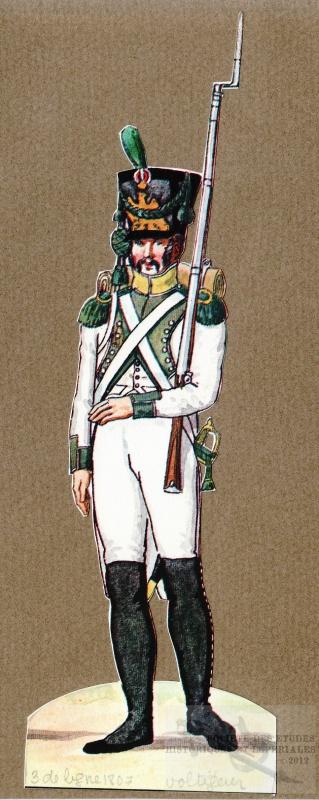 he notes Kolbe has given wholly green cuffs that should have been white with piping (passepoilés) of green and the pockets (even if visible or another illustration) are piped around green.
he notes Kolbe has given wholly green cuffs that should have been white with piping (passepoilés) of green and the pockets (even if visible or another illustration) are piped around green.The plate on the shako for 3e de Ligne could be either of the nominal form of rhombic (regulatory shape) diamond or according to Kolbe (in any case for these voltigeurs) the larger crowned Eagle above a rectangular base. [Note it retains its’ copper red brass colouration].
There are several cases in his series of drawings where the plates of shako are different according to the various companies of the same regiment, companys d’elite versus average/ fusilier companys.
Normally, the rank braid and insignia of non-commissioned officers are of the colour of the metal buttons : yellow for corporals and gold for sergeants if the buttons of brass or copper; alternatively white and silver if buttons are of white metal (tin).
In the case of the 3e de Ligne with the white habit the buttons should be and the rules of yellow ones for its series and therefore, the braids grade- yellow or gold. In this it is found that Kolbe gives the Voltigeur white buttons. Who’s is the error- the uniform provider or the illustrator?
In addition, Didier notes about Rigo plate:
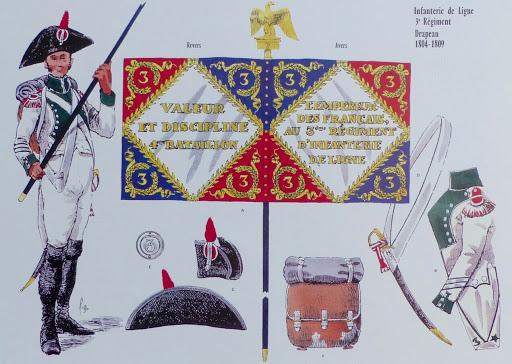
Rigo in his plate on the Drapeau Sergeant-Major Porte-Aigle has extrapolated this theme to the entire
regimentbattalion, and therefore in his design obviously has given the rank of sub-officer ‘silver’ instead of the expected gold attributes.But the white buttons may only be a feature of the base fusiliers (if any); or the rest of the regiment retaining it regulation yellow/ brass buttons (as seen on the drawing of a sapper in the 3eme Line of the same series).
The rank distinctions of non-commissioned officers of fusiliers, therefore, are yellow or gold, without a doubt piping of green.Didier adds:
The shako was distributed as a priority to certain companys, the elites and fusilers, while their cast-off ‘chapeaux’ were then re-distributed to the 3eme Bon at the end of 1807.
A further document in graphic form was a detailed Lucien Roussselot document detailing many details of the uniform. In this he cites many variations and reminds us of the supposed rules, then cites variations and descriptions. He is sometimes sceptical of the ‘Collections Alsaciennes’ and ‘Petit Soldats’ as the copyists who made them more famous.
He also confirms from Inspection Reports the variety of shakos, when used and after a years delay receiving any (literally by 1808), displaying four different plates between various companys.
He also adds that the carrot pompom of the chapeaux were reused on the new shakos. He notes Colonels purchased these based on varying criteria- less cost, mre stable or more decorative, as their whims and desires showed.
regards, dave
19/04/2024 at 04:35 #197456 OotKustParticipant
OotKustParticipantAaannndd, on ‘modern artists’, I’ve noted the last couple of years a lot of plumage creeping in- whether these are unadulterated originals I don’t know and can’t validate- but Patrice Courcelle has added many a ‘marshals’ white plumage to Generals, who were not Marshals, and ADC’s (as Gen officers also) to the man N.
Along these lines-
 Rapp, shown here, and certainly not the first one, was a General de Brigade since 1803, was N.s fourth ranked ADC by seniority in 1805 but held ‘special’ roles due to his primarily German language and skills.
Rapp, shown here, and certainly not the first one, was a General de Brigade since 1803, was N.s fourth ranked ADC by seniority in 1805 but held ‘special’ roles due to his primarily German language and skills.He did not qualify as a Commandant-en-Chef until 1814 and if anything other than ceremonial duties, would usually be understated in dress rather than exuberent.
Gorgaud ditto, has been given a General officers ‘black’ plumage fringe, again to which he did not qualify by rank at all. Whether this affectation was truly adopted by the ‘barbeau-bleu’ dressed Imperial Officiers d’Ordonance is equally a mystery.
The one and only person who may have qualified, by both role and duties, for the white plumage was GDV Duroc- his penultimate role as N.s confessor, confidante and guard of his person and estates, both civil and militarily, as Grand-Marescal du Palais, from 1801 was a unique one.
Again he was a fairly understated man and ‘if’ he wore the plumage, it appears in period paintings a smaller and less ‘oversized’ as the Marshals proper wore (ie their gold oak and laurel leaves lace was 80mm vs 50mm total than that of other ‘Generals’ GDVs classes, as well as being a triple layer of ‘chains’ etc.).
As to gaming, well as we know ‘anything goes in my army’ yet I don’t care for the addition and distinctives on many ‘manufactured’ models.
In my own defence, for my 25mm French I have to create ‘ranks’ from lower embellished figures- such as plain Austrian ADC’s to become French, getting assorted epaulettes, cordage and unique head/ chapeau replacements and the odd colpack (where deserved and fairly rare as early as 1805…).
regards
-d -
AuthorPosts
- You must be logged in to reply to this topic.


